Jinnah International Airport
| Jinnah International Airport جناح بین الاقوامی ہوائی اڈا | |||||||||||||||
|---|---|---|---|---|---|---|---|---|---|---|---|---|---|---|---|
 | |||||||||||||||
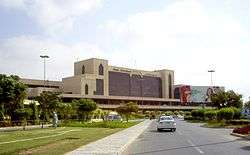 | |||||||||||||||
| IATA: KHI – ICAO: OPKC | |||||||||||||||
| Summary | |||||||||||||||
| Airport type | Public | ||||||||||||||
| Owner/Operator | Pakistan Civil Aviation Authority | ||||||||||||||
| Serves | Karachi | ||||||||||||||
| Location | Karachi, Sindh, Pakistan | ||||||||||||||
| Hub for |
airblue Air Indus Pakistan International Airlines Shaheen Air Serene Air Star Air Aviation (Cargo) Vision Air International Princely Jets | ||||||||||||||
| Elevation AMSL | 100 ft / 30 m | ||||||||||||||
| Coordinates | 24°54′24″N 67°09′39″E / 24.90667°N 67.16083°ECoordinates: 24°54′24″N 67°09′39″E / 24.90667°N 67.16083°E | ||||||||||||||
| Website |
karachiairport | ||||||||||||||
| Map | |||||||||||||||
 KHI  KHI | |||||||||||||||
| Runways | |||||||||||||||
| |||||||||||||||
Jinnah International Airport (Urdu: جناح بین الاقوامی ہوائی اڈا) (IATA: KHI, ICAO: OPKC) is Pakistan's largest and busiest international and domestic airport. Located in Karachi, the largest city and capital of the Sindh province, it is named after Muhammad Ali Jinnah, the founder of Pakistan.
The airport provides a hub for the flag carrier, Pakistan International Airlines (PIA), Air Indus, Shaheen Air, airblue and many other private airlines. The airport is equipped with aircraft engineering and overhauling facilities including the Ispahani Hangar for wide-body aircraft.[1] In 2014-2015, 6,419,523 passengers used the airport and there were 48,837 aircraft movements.[2] Concourse East is currently used by Oneworld, Star Alliance and SkyTeam members and non-affiliated airlines.
History
.jpg)

J. R. D. Tata, the father of civil aviation in British India made the maiden voyage from Juhu Aerodrome in Bombay to Drigh Road airstrip (now Jinnah International Airport), Karachi, via Ahmedabad, on 15 October 1932 carrying mail in a Puss Moth aircraft.[3]
During the 1940s there was a large black coloured hangar at the site of Karachi Airport, constructed for the British R101 Airship. Only three hangars were ever built in the world to dock and hangar the R101 airships. However, the R101 airship never arrived in Karachi (then part of the British Raj) as it crashed early in its journey in France. This hangar was so huge that aircraft often used it as a visual marker while attempting VFR landings at Karachi. Over the years, the hangar became known as the landmark of Karachi, until it was demolished by order of then-President Ayub Khan in the 1960s.
During World War II, Karachi Airport was a major transhipment base for United States Army Air Forces units and equipment being used by Tenth Air Force in eastern India, Burma and the Fourteenth Air Force in China. Several operational bomber and fighter units flew into Karachi for short organisational periods prior to their deployment. Air Technical Service Command had extensive facilities where aircraft were received, assembled and tested prior to being flown to their combat units at forward airfields. It also functioned as a major maintenance and supply depot for both air forces. In addition, Air Transport Command flew numerous cargo and passenger flights to the Middle East and to points within British India and China.
The airport facilities were further expanded in the 1980s to Terminal 2 and Terminal 3 respectively. The present day infrastructure of Jinnah International Complex is a result of an expansion programme carried out in 1994. Today, the new Jinnah Terminal handles both domestic and international flights, whereas Terminal 2 is now dedicated to Hajj operations. Terminal 1 (the original airport) is now the HQ of Pakistan's Civil Aviation Authority and Terminal 3 is dedicated to commercial offices.[4]
Karachi was once a much busier airport. Between the 1960s and 1980s it was an online station of several major airlines of the world including Air India, British Airways (now operating via codeshare with Qatar Airways), Interflug, TAROM, Alitalia (now operating via codeshare with Etihad), JAT Yugoslavia Airlines, Aeroflot, Philippine Airlines, Nigeria Airways, Ethiopian Airlines, EgyptAir, East African Airways, Kenya Airways (now operating via codeshare with Etihad), Air France, Qantas, Pan Am, Royal Jordanian, Libyan Arab Airlines, Japan Airlines, Syrian Arab Airlines, Middle East Airlines, Lufthansa, Swissair and SAS. Other former airlines were Azerbaijan Airlines, Garuda Indonesia, Kazakhstan Airlines, KLM (now operating via codeshares with Etihad and Gulf Air), Kuwait Airways, Kyrgyzstan Airlines, Libyan Arab Airlines, Transportes Aéreos da Índia Portuguesa and Uzbekistan Airways. However, due to the emergence of Dubai's airport on the world map, increased usage of longer haul aircraft, expensive fuel prices in Pakistan and the poor political climate of Karachi during the 1990s, several airlines discontinued their service to the airport.
In the past couple of years Karachi has seen a reversal in fortunes. The dwindling number of international airlines has stabilised and whilst there has not been a marked increase in the number of airlines flying in to Karachi, some have either increased the number of flights or resumed their old operations, either online or via codeshare service.
On 8 June 2014, at least 10 militants armed with automatic weapons,[5][6][6] a rocket launcher, suicide vests and grenades attacked the airport; 36 people were killed, including all 10 attackers and at least 18 people were wounded.
Structure
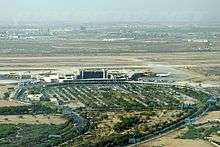
Jinnah International Airport has a capacity of handling 12 million passengers annually. In fiscal year 2008–2009, over 5,725,052 passengers used Jinnah International Airport. 50,095 aircraft movements were registered.[7] Jinnah International Airport in Karachi has always been the largest aviation facility in Pakistan. It is the primary hub of Pakistan International Airlines (PIA). All other Pakistani airlines also use Jinnah International Airport as their main hub. These include airblue and Shaheen Air, as well as several charter carriers. The building is linked via connecting corridors to two satellites, each having a provision of eight passenger-loading bridges. The eastern satellite is devoted exclusively to handling international operations. The western satellite is used for domestic operations, as well as some international operations. This is achieved through a flexible arrangement of gates. The two satellites supplement the departure lounges of the terminal building and also provide shopping facilities, mobile recharging points, and snack counters.
The Jinnah Terminal was completed in 1992 at a cost of US $100 million – at the time the most expensive civil construction project in Pakistan. NESPAK (National Engineering Services Pakistan) and Airconsult (Frankfurt, Germany) were responsible for the architecture and planning of the terminal. Sogea Construction, a French company, was the contractor. Mukhtar Husain and Abdul Malik (NESPAK) were the Chief Engineers for the new terminal. In Karachi, the CIP Lounge can be used by all first and business class passengers on all outbound flights. Barclays, UBL and airblue have also introduced their dedicated lounges in the international terminal of the airport.[8] There are a number of bank kiosks and ATMs that passengers can use at the airport. The airport is also where the majority of PIA's maintenance network is located, although some of its maintenance work also takes place at Benazir Bhutto International Airport, Rawalpindi. There are several hangars at the airport; the largest being the Ispahani Hangar (named after Mirza Ahmad Ispahani, the first chairman of PIA) that can accommodate two Boeing 747s and one narrow body airliner (e.g. Boeing 737) at one time. On 15 February 2006, the first major overhaul of a Boeing 777-200ER aircraft (known as "C" check) was done at Ispahani Hangar. Most of the PIA aircraft are checked and regulated at the aircraft hangars in Karachi. The PIA maintenance also check other airline aircraft in Karachi such as Philippine Airlines, Turkish Airlines and Air Universal. The head office of the Civil Aviation Authority of Pakistan is located in Terminal 1.[9] Pakistan International Airlines has its head office on the grounds of the airport (PIA Building),[10] as well as its central mainframe (CRC Building) which also houses its frequent flyer programme, Awards +, as well as hosting SITA Bagtrak, the shared International Air Transport Association global lost luggage tracking computer network. PIA Engineering HQ, Cargo Village and Flight Kitchen are also located here. Terminals 1 and Jinnah West also have round-the-clock PIA booking offices and ticketing auto-kiosks. Shaheen Air also has its head office on the airport property.[11]
Ispahani Hangar

The Ispahani Hangar is PIA's wide-body aircraft maintenance hangar at Jinnah International Airport. It has been named in honour of Mr. Mirza Ahmad Ispahani. Mirza Ahmad Ispahani was the first and longest serving chairman of Pakistan International Airlines from its inception in 1954 until 1962. The new jet hangar for wide body and narrow body aircraft with a supporting airframe overhaul shop was completed and commissioned in 1968. Most of the PIA aircraft are checked and regulated at the aircraft hangars in Karachi. The PIA maintenance also check other airline aircraft in Karachi such as Philippine Airlines, Yemenia and Turkish Airlines.
Terminals
Jinnah Airport has one main terminal, divided into two concourses:[12]
- The Jinnah East Satellite Concourse, used for international flights
- The Jinnah West Satellite Concourse, used for domestic flights
Runways and aprons
The airport has two runways measuring 3,200m and 3,400m in length respectively. Runways, 25R/07L and 25L/07R each have a width of 46 m (250 ft)and 45m respectively. Capable of handling up to Boeing 747, Boeing 787 Dreamliner & Antonov An-225 Mriya aircraft. The runways have capacity to handle 15 flights per hour and it accommodate simultaneous landing and take off. Runway 25R and 25L is equipped with ILS CAT-I to guide landing aircraft safely under very poor weather conditions and also allowing planes to land in low visibility conditions, such as fog.[13] The taxiway is able to handle 12 aircraft at any one moment while the parking area measures 266,000 sq metres and is able to accommodate 42 aircraft, 12 of which through air bridges linking them directly with the terminal building. In addition to this, there are remote parking bays for 30 aircraft.
Airlines and destinations
.jpg)
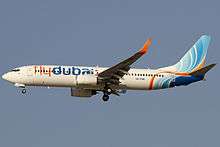
%2C_UTair_Aviation_JP7587837.jpg)
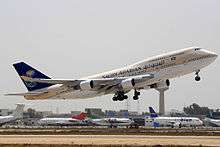
Passenger
Jinnah International Airport connects Karachi with 69 cities worldwide(including domestic destinations) by both passenger and cargo flights. Up to 45 airlines operate regular flights to/from the airport.
Notes:
- ^a : Air China's flight from Beijing to Karachi make a stop in Islamabad but the flight from Karachi to Beijing is nonstop. Air China does not have eighth freedom rights on the Karachi-Islamabad sector.
Cargo
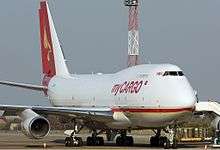
Ground transport
Jinnah International Airport is situated in the well populated area of Gulistan-e-Jauhar and it is easily accessible through Airport Road from any part of the city.
The Airport has a wide parking area which can accommodate more than 800 vehicles.
Bus and mini bus and taxis are also available to the airport. There are also a number of traditional rickshaws available at the airport parking area & entrance which are quite popular to travel short distance within the city.
Karachi Cantonment railway station is the nearest railway station from the airport to get the railway connections for the other parts of country. A commuter rail station is also near the airport, a five-minute drive distance. However Karachi's commuter train service was stopped several years ago hence this is no longer an available transport option.
Accidents and incidents
| Date | Aircraft | Registration | Flight no | Airline | Occupants | Fatalities | Details |
|---|---|---|---|---|---|---|---|
| 27 December 1947 | Douglas DC-3 | VT-AUG | Air-India | 23 | 23 | The DC-3 lost control after takeoff and struck the ground in a 30deg angle whilst in a violent sideslip to the right.[20] | |
| 3 March 1953 | de Havilland DH-106 Comet 1A | CF-CUN | Canadian Pacific Air Lines (CP Air) | 11 | 11 | Failed to takeoff and crashed into a dry river bed. First fatal passenger jet airliner crash.[21] | |
| 5 August 1956 | Hermes IV | G-ALDK | Britavia | Suffered the collapse of the nose undercarriage at Drigh Road Airport. The aircraft was damaged beyond economic repair.[22] | |||
| 14 August 1959 | Vickers Viscount | AP-AJE | Pakistan International Airlines | 3 | 2 | Aircraft crashed at Karachi International Airport while attempting an overshoot with two engines inoperative on a training flight.[23] | |
| 5 September 1986 | Boeing 747-121 | Pan Am Flight 73 | Pan American World Airways | 20 | Aircraft was hijacked by Palestinian gunmen posing as airport officials upon arrival from Bombay (now Mumbai), India. 20 people were killed when the gunmen opened fire on the passengers as commandos prepared to storm the airplane whilst still on the ground. | ||
| 5 November 2010 | Beechcraft 1900 | JS Air | 21 | 21 | A plane chartered by the Italian oil company, ENI crashed a minute after takeoff. All 21 passengers & crew on board - 17 ENI employees, 2 pilots, a security guard and a technician - were killed. Among the dead were 20 Pakistani nationals and 1 Italian national.[24] | ||
| 28 November 2010 | Ilyushin Il-76 | 4L-GNI | Sun Way Flight 4412 | Sun Way | 8 | 10 | Aircraft crashed in a populated area of Karachi shortly after taking off from Jinnah International Airport. All eight people on board were killed, as were a further two people on the ground. The aircraft was reported to have been trying to return to Jinnah International after suffering an engine fire.[25] |
Terrorist attack
On 8 June 2014, 10 militants armed with automatic weapons, a rocket launcher, suicide vests, and grenades attacked Jinnah International Airport in Karachi, Pakistan. 36 people were killed, including all 10 attackers, and 18 others were wounded.[26] Two aircraft of PIA (a Boeing 747 and an Airbus A310) and one Air Indus plane were reported damaged. The damage to the Air Indus aircraft was extensive, which rendered it nonoperational, leading to the demise of the airline.[27]
See also
- Civil Aviation Authority of Pakistan
- Shaheen Airport Services
- Transport in Pakistan
- Airblue
- Shaheen Air
- Air Indus
References
![]() This article incorporates public domain material from the Air Force Historical Research Agency website http://www.afhra.af.mil/.
This article incorporates public domain material from the Air Force Historical Research Agency website http://www.afhra.af.mil/.
- ↑ Welcome to Jinnah International Airport Karachi
- ↑ http://www.caapakistan.com.pk/AT/AT-EO-Stats.aspx
- ↑ Pran Nath Seth; Pran Nath Seth; Sushma Seth Bhat (2005). An introduction to travel and tourism. Sterling Publishers Pvt. Ltd. Retrieved 20 February 2011. Page 112
- ↑ Paul Stephen Dempsey (1999), Airport Planning & Development Handbook: a global survey. McGraw-Hill Professional. ISBN 978-0-07-134316-9
- ↑ "Karachi Airport attacked; Indian weapons recovered from the terrorists". Nation.com.pk. Retrieved 2014-06-11.
- 1 2 Dennis Lynch (8 June 2014). "Militant Attack On Karachi Airport In Pakistan Claims 23 Lives, At Least 14 Wounded". International Business Times. Retrieved 1 June 2015.
- ↑ caapakistan.com.pk - Aviation Statistics
- ↑ "ThePost News Updates! - Pakistan, Real Estate and Telecom News!". ThePost News Updates!. Retrieved 1 June 2015.
- ↑ "Contact Us." Civil Aviation Authority of Pakistan. Retrieved on 3 May 2010.
- ↑ "Contact Us." Pakistan International Airlines. Retrieved on 23 February 2010.
- ↑ "Contact Us: Domestic." Shaheen Air. Retrieved on 28 July 2010.
- ↑ Jinnah International Website
- ↑ "World Aero Data: JINNAH INTL -- OPKC". Retrieved 1 June 2015.
- ↑ ": : : Airblue : : : flight schedules". Retrieved 1 June 2015.
- ↑ "Pakistan International Adds New Domestic Routes from May 2015". Retrieved 1 June 2015.
- ↑ Archived 5 November 2014 at the Wayback Machine.
- ↑ IAMC announce Sharjah
- ↑ "Star Air Aviation (Pvt) Ltd.". Retrieved 1 June 2015.
- ↑ "Turkish Cargo S15 Operations". Retrieved 1 June 2015.
- ↑
- ↑ CPAL crash details Aviation Safety Network. Retrieved 13 January 2011
- ↑ Chesterfield, Lyn. "Hermes prang". Aeroplane. No. January 2011. Kelsey Publishing. p. 82.
- ↑ "Accident description". Aviation Safety Network. Retrieved 11 September 2009.
- ↑ "22 killed when small plane crashes in Pakistan". CNN International. July 5, 2010. Retrieved 13 July 2010.
- ↑ Hradecky, Simon. "Crash: Sun Way IL76 at Karachi on Nov 28th 2010, engine fire". The Aviation Herald. Retrieved 28 November 2010.
- ↑ "Karachi airport attack". Dawn. Dawn. 10 June 2014. Retrieved 2 June 2016.
- ↑ "CAA suspends Air Indus' operations for violating safety regulations". Dawn. Dawn. 1 July 2015. Retrieved 2 June 2016.
External links
 Media related to Jinnah International Airport at Wikimedia Commons
Media related to Jinnah International Airport at Wikimedia Commons - Official website
- Jinnah International Airport at the Civil Aviation Authority of Pakistan
- Airport information for OPKC at World Aero Data. Data current as of October 2006.
- Current weather for OPKC at NOAA/NWS
- Accident history for KHI at Aviation Safety Network
.png)